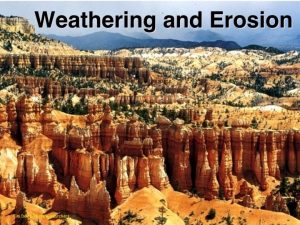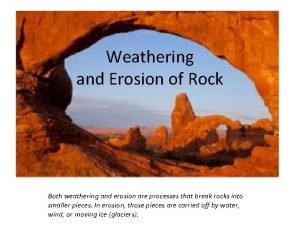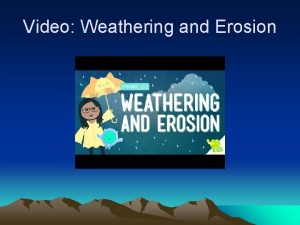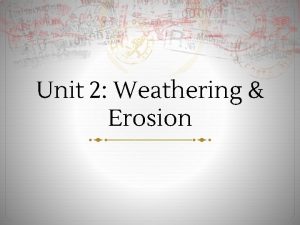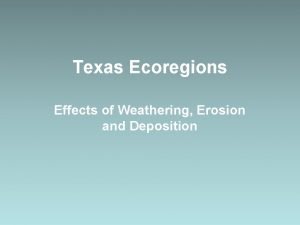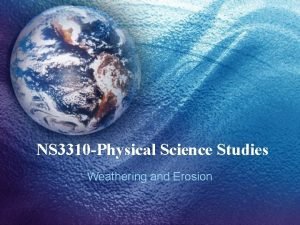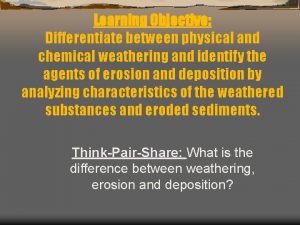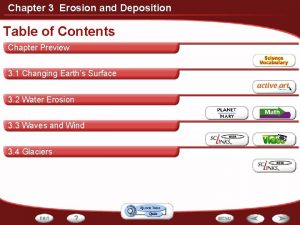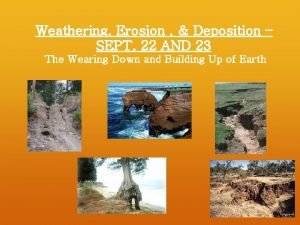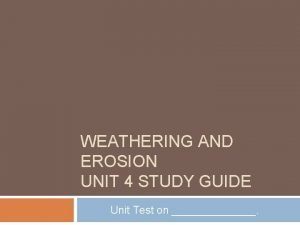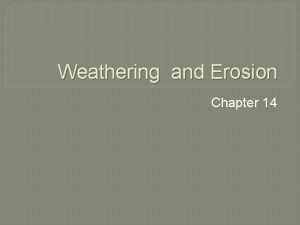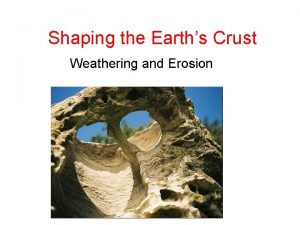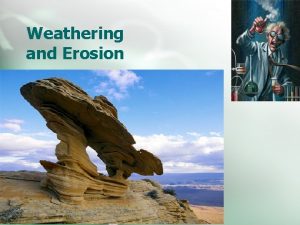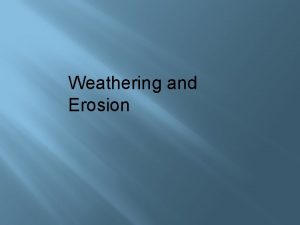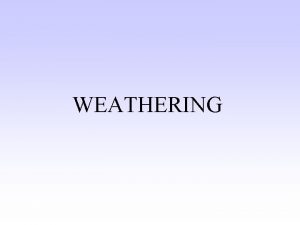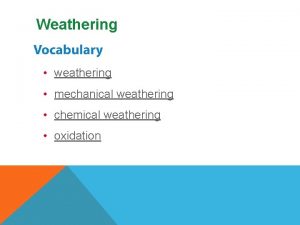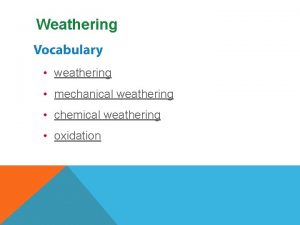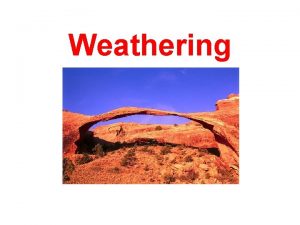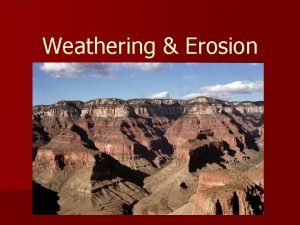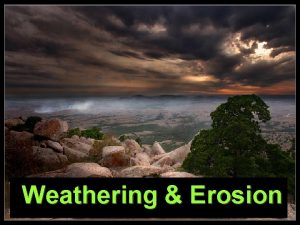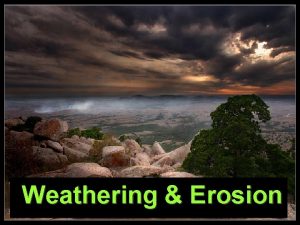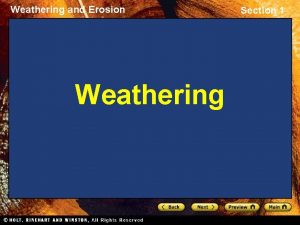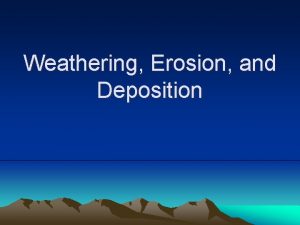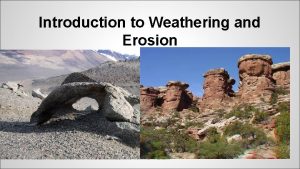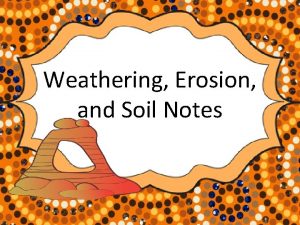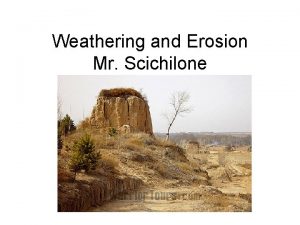Shaping the Earths Crust Weathering and Erosion Shaping



















- Slides: 19

Shaping the Earth’s Crust Weathering and Erosion

Shaping the Earth’s Crust • The rocks and soil of the earth’s crust are continually being worn down because of a number of processes. • These processes are known collectively as Denudation. • Denudation occurs as a result of both weathering and erosion.

Denudation • Denudation is caused by both weathering and erosion. Denudation Weathering 1. 2. Mechanical Weathering Chemical Weathering Erosion 1. Moving water (rivers/sea) 2. Moving Ice (glaciers) 3. Moving Air (wind).

Weathering and Erosion Weathering • Weathering means the breakdown of rocks that are exposed to the weather. • There are two types of weathering, Mechanical Weathering and Chemical Weathering Erosion • Erosion means the breakdown of rocks and the removal of their particles. • Erosion is caused by moving air (wind), moving water (rivers/sea), and moving ice (glaciers).

Mechanical Weathering • Mechanical weathering breaks up the rocks into smaller pieces. • One type of mechanical weathering is called Freezethaw action. • Freeze-thaw action breaks the rock into smaller pieces. • It occurs high in the mountains where there is lots of rain and the temperature rises above and below 0 degrees Celsius quite often.

Freeze-Thaw Action

Chemical Weathering • Chemical weathering dissolves rocks. • One example of chemical weathering is called Carbonation. • Carbonation occurs in limestone landscapes, where bare limestone rock is exposed to the rain. • It occurs because rainwater mixes with carbon dioxide in the atmosphere, forming a weak carbonic acid. • This acid reacts with calcium carbonate in the limestone, causing the rock to slowly dissolve.

Carbonation – Karst Landscapes • Carbonation occurs in areas where bare limestone rock is exposed to the weather. • These areas are known as karst landscapes, after a limestone region called Karst in Slovenia. • An example of a Karst landscape in Ireland is the Burren in Co. Clare. • Here the soil has been worn away, leaving the bare limestone rock exposed. Carbonation has created many spectacular features, particularly underground.

A Karst Limestone Pavement




Mass Movement • Mass movement means the movement of any loose material (rocks, soil, mud) down slope under the influence of gravity. • The loose material is known as regolith. • The rate of mass movement is influenced by 4 factors. • • Gradient Water Content Human Activity Vegetation

Influences on Mass Movement • Gradient – Mass movement occurs on sloping land. Mass movement is fastest on steep slopes. • Water Content – After heavy rain the regolith (loose material) is heavier. • Human Activity – People often cut into hillsides to make roads or railway lines. This creates steep slopes where mass movement can occur. • Vegetation – The roots of trees and plants help keep the regolith together, slowing down mass movement.

Types of Mass Movement • There are different types of mass movement. They are grouped according to the speed at which they occur. Types of Mass Movement Speed – Slow Speed – Fast 1. Soil Creep 1. Landslides 2. Bog bursts 3. Mudflows

Soil Creep

Soil Creep

Landslides

Mudflows
 Most abundent element in earths crust
Most abundent element in earths crust How thick is the earths crust
How thick is the earths crust Which layers together constitute the lithosphere?
Which layers together constitute the lithosphere? Earths crust
Earths crust Erosion types
Erosion types Gulf coast weathering
Gulf coast weathering The three types of weathering
The three types of weathering Double jeopardy
Double jeopardy Bill nye weathering and erosion
Bill nye weathering and erosion Hydrolysis weathering definition
Hydrolysis weathering definition Weathering and erosion difference youtube video
Weathering and erosion difference youtube video Questions on weathering and erosion
Questions on weathering and erosion Weathering erosion and deposition in blackland prairie
Weathering erosion and deposition in blackland prairie South texas plains erosion
South texas plains erosion Get5gets.com
Get5gets.com Physical erosion
Physical erosion Weathering erosion and deposition
Weathering erosion and deposition Weathering and erosion
Weathering and erosion Weathering erosion
Weathering erosion Chapter 14 weathering and erosion review answers
Chapter 14 weathering and erosion review answers






